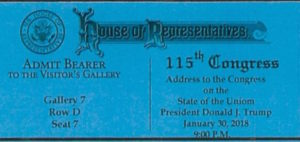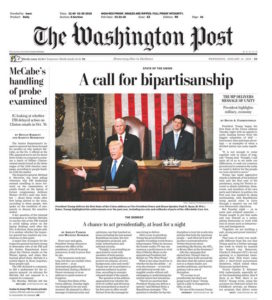Donald Trump’s first State of the Union address was always going to be noteworthy. With commentators anticipating yet another “pivot” to normality, the millions watching – whether or not they support him – should have known it would hit some familiar themes.
 At first it looked like the tickets might have to be reprinted because of a typo, but in a way it was probably the perfect metaphor for the presidency thus far: ‘who cares if it’s accurate, you all know what it means, right?’ Stephen Colbert tweeted: “Is it possible that “President Donald Trump” is also a typo?”
At first it looked like the tickets might have to be reprinted because of a typo, but in a way it was probably the perfect metaphor for the presidency thus far: ‘who cares if it’s accurate, you all know what it means, right?’ Stephen Colbert tweeted: “Is it possible that “President Donald Trump” is also a typo?”
This showcase appearance at the end of Trump’s first year in office was always going to be marked by something more of a circus atmosphere than usually surrounds these events. After his first joint address to Congress last March went off smoothly, there had been talk of a “new” Trump, with this reaction from one of his aides: “For once, we had the wind at our sails. We decided not to sh*t on ourselves.”
How would it go last night?
In the run-up to the address, there was the inevitable talk of low bars, resets and normalization, and we were ready for articles on how the President “became Presidential.”
But regardless of how Trump performed, for some context of what was surrounding his administration, consider some of the things that happened just in the 48 hours before he strode to the podium:
Andrew McCabe, the Deputy Director of the FBI, announced he was stepping down a month earlier than planned, while there was talk that the House Intelligence Committee was set to investigate the FBI and Department of Justice.
The same committee voted to release the controversial Devin Nunes memo that apparently attacks McCabe, James Comey and Deputy Attorney General Rod Rosenstein. Nunes won’t say whether he worked with the White House in creating the memo, while the Democrats’ own memo apparently contextualizing the Nunes document appears unlikely to see the light anytime soon.
And, perhaps most significantly, the administration said it would not be implementing agreed bipartisan sanctions on Russia, claiming they are “not needed.” (Incidentally, neither the White House or the State Department had issued a statement on the arrest of Russian opposition leader Alexei Navalny during anti-Putin protests at the weekend.)
All that came after the President’s allies – particularly those at Fox News – had become increasingly vehement in their attacks on the so-called “deep state”.
Meanwhile, a disagreement over policy towards North Korea may have “derailed” the White House choice for ambassador to South Korea – Victor Cha later writing that the idea of giving the North a “bloody nose” carried a huge risk.
As for the “circus” of the speech itself, there was speculation – in some quarters at least – over whether the First Lady would even show up. The other woman on everyone’s lips recently, Stormy Daniels – who issued a new defiant statement and really wants you to follow her on Instagram – was preparing to be the guest on Jimmy Kimmel’s late night show.
As it happened, the First Lady, who arrived separately from her husband, was in the gallery accompanied by parents of two children murdered by members of Salvadoran gang MS-13. Benjamin Wallace-Wells wrote in the New Yorker how that was a telling optic.
If the state of the union in the most powerful and wealthiest nation on Earth is actually strong, what does a street gang have to do with anything? The choice gives some insight into the nature of the Trump era, one year in, with his party in unified control of government in Washington but his Presidency historically unpopular. During the State of the Union, the President gets to describe his agenda but also set the national scene. Trump is giving significance to an immigrant street gang. He is in search of an enemy.
And there were plenty of references to those aspects of immigration designed to make Americans fearful. Jennifer Rubin called the speech “a diatribe against immigrants” and said it was the perfect reflection of the President: “self-satisfied, self-congratulatory, disingenuous and entirely lacking in empathy.”
The divisive language on immigration will likely continue to dominate debate on Washington’s current hot policy topic, the state of which was probably summed up by a GOP Congressman who asked the Capitol Police to arrest any “undocumented immigrants” who may have been attending the speech.
Pure political theatre
In terms of what Trump’s speechwriters sought to achieve, it would probably be considered a well-crafted address; long, certainly – an hour and twenty minutes – and making good use of the traditional human props; there were more balcony guests with genuinely heart-wrenching personal stories than usual.
The rhetoric reached out beyond his base – somewhat removed from the “American carnage” of his inaugural speech – but most likely only to other Republicans who may have heard echoes of a more traditional GOP standard-bearer. Peter Baker writes at the New York Times that while Trump can sell an improved economy “he has not been able to sell himself.”
ProPublica, meanwhile, fact-checked the President’s economic victory lap by asking “What happened to all those jobs?”while PolitiFact debuted a fact-checking app called FactStream, which attempted to fact check delivery in real-time.
 This morning’s Washington Post front page was probably exactly the sort of coverage the White House would have wanted to see – even if some readers disagreed. Nate Silver at 538, for example, tweeted that he didn’t buy the framing. “The speech was fairly conventional stylistically, but the last 3/4 of the speech were quite partisan, substantively, especially by SOTU standards.”
This morning’s Washington Post front page was probably exactly the sort of coverage the White House would have wanted to see – even if some readers disagreed. Nate Silver at 538, for example, tweeted that he didn’t buy the framing. “The speech was fairly conventional stylistically, but the last 3/4 of the speech were quite partisan, substantively, especially by SOTU standards.”
The Post’s Dan Balz wrote that “Trump commanded the nation’s focus with a review of successes and an outline of his second-year priorities. And yet, the record of the past year shows that the president has chosen to stir controversy and stoke existing partisanship rather than do the harder work of bringing the country together.
Richard Wolffe at The Guardian wrote that this was “the kind of night Donald Trump loves best – when he can applaud himself.” And the President was even able to virtually applaud those who had given him money, since the official online livestream featured the scrolling names of Trump donors.
While there was no direct reference to Robert Mueller’s investigation – or even any warning to Russia over future election meddling – there was something of a cryptic line about giving government agencies the power “to remove federal employees who undermine the public trust or fail the American people.”
On foreign policy, as with the immigration rhetoric, the theme of America First was prominent. There were warnings of the threat from North Korea, and an argument in favour of “unmatched power” in a call for increased military spending. As the President spoke, the White House released details of an executive order extending the operation of the detention facility at Guantanamo Bay.
There was praise for the campaign against ISIS, but just two sentences on the complex situation in Afghanistan – America’s longest war.
**
Read the full speech transcript here, annotated by the New York Times.
And here’s an annotated version from the FT:
Our @FT annotations to Trump's #SOTU. (Including my pithy trade thoughts) https://t.co/fBM4XGT2X1 pic.twitter.com/7VAShFOZC4
— Shawn Donnan (@sdonnan) January 31, 2018
Watch the full speech, and the Democratic response by Congressman Joseph Kennedy here:
WATCH: President Trump FULL State of the Union Address https://t.co/S5WRbdypkH
WATCH: @RepJoeKennedy FULL Democratic Response to the State of the Union https://t.co/wddnEj2JjV
#SOTUResponse #SOTU #SOTU2018 pic.twitter.com/6D98jwGQFl— CSPAN (@cspan) January 31, 2018
**
Trump’s ‘Righteous mission’
Trump had told TV anchors at the White House earlier in the day that he would “consider it a great achievement if I could make the country united.” Whether you believe this particular speech was conciliatory enough to advance that process largely depends on what you already thought of him.
As most people agree by now, TelePrompTer Trump isn’t the problem – his delivery is almost vacantly soothing, in fact – but Twitter Trump often is; so we’ll have to wait to see how the next couple of days unfold when he gets back on his favourite medium. According to Twitter, this was the most-tweeted State of the Union speech ever; the most-tweeted moment? When he took a shot at the peaceful protests of NFL players by saying “we stand for the national anthem.” Interestingly, the second most tweeted-about person during the speech, after Trump himself, was Barack Obama.
So, after another Trump performance that mixed emotion with competence, the rest of us who share the Republic with him are no wiser as to what he will actually do next; how the next part of this remarkable democratic experiment will unfold. And that’s kind of the idea. Ezra Klein recently wrote at Vox that “Trump is winning… [by] making us a little more like him, and politics a little more like the tribal clash he says it is.”
‘He is a highly divisive figure,’ says George Edwards, a political scientist at Texas A&M who studies presidential rhetoric. ‘He doesn’t convince anyone on the other side. He doesn’t move the public. He cannot reach out beyond people already committed to him.’
But there is another Trump presidency — that of Donald J. Trump, reality television star and international brand. This is the presidency that I suspect matters more to Trump himself, the one that he pursues during his morning ‘executive time,’ the one he furthers with every tweet, the one he obsessively monitors on cable news. This is the presidency for which the measures of achievement aren’t bills passed or jobs created but headlines grabbed and mindshare held.
This is the presidency that, for all its collateral damage, is succeeding beyond Trump’s wildest dreams. This is the presidency that few have figured out how to resist.
Also published on Medium.
